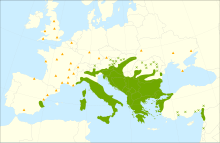| Manna ash South European flowering ash | |
|---|---|

| |
| Foliage and flowers | |
| Conservation status | |
 Least Concern (IUCN 3.1) | |
| Scientific classification | |
| Kingdom: | Plantae |
| Clade: | Tracheophytes |
| Clade: | Angiosperms |
| Clade: | Eudicots |
| Clade: | Asterids |
| Order: | Lamiales |
| Family: | Oleaceae |
| Genus: | Fraxinus |
| Section: | Fraxinus sect. Ornus |
| Species: | F. ornus |
| Binomial name | |
| Fraxinus ornus L. | |

| |
| Distribution map | |
Fraxinus ornus, the manna ash or South European flowering ash, is a species of Fraxinus native to Southern Europe and Southwestern Asia, from Spain and Italy north to Austria and the Czech Republic, and east through the Balkans, Turkey, and western Syria to Lebanon and Armenia.
Description
Fraxinus ornus is a medium-sized deciduous tree growing to 15–25 m (49–82 ft) tall with a trunk up to 1 m diameter. The bark is dark grey, remaining smooth even on old trees.
The buds are pale pinkish-brown to grey-brown, with a dense covering of short grey hairs.
The leaves are in opposite pairs, pinnate, 20–30 cm (7.9–12 in) long, with 5 to 9 leaflets; the leaflets are broad ovoid, 5–10 cm (2–4 in) long and 2–4 cm (0.8–2 in) broad, with a finely serrated and wavy margin, and short but distinct petiolules 5–15 mm (0.20–0.59 in) long; the autumn colour is variable, yellow to purplish.
The flowers are produced in dense panicles 10–20 cm (3.9–7.9 in) long after the new leaves appear in late spring, each flower with four slender creamy white petals 5–6 mm (0.20–0.24 in) long; they are pollinated by insects.
The fruit is a slender samara 1.5–2.5 cm (0.59–0.98 in) long, the seed 2 mm (0.08 in) broad and the wing 4–5 mm (0.2–0.2 in) broad, green ripening brown.
Cultivation and uses
Fraxinus ornus is frequently grown as an ornamental tree in Europe north of its native range for its decorative flowers—the species is also sometimes called "flowering ash". Some cultivated specimens are grafted on rootstocks of Fraxinus excelsior, with an often very conspicuous change in the bark at the graft line to the fissured bark of the rootstock species.
A sugary extract from the sap may be obtained by making a cut in the bark; this was compared in late medieval times (attested by around 1400 AD) with the biblical manna, giving rise to the English name of the tree, and some of the vernacular names from its native area (fresno del maná in Spanish, frassino da manna in Italian). In fact, the sugar mannose and the sugar alcohol mannitol both derive their names from the extract.
References
- Rivers, M.C.; Harvey-Brown, Y.; Barstow, M. (2017). "Fraxinus ornus". IUCN Red List of Threatened Species. 2017: e.T61918784A112585867. doi:10.2305/IUCN.UK.2017-3.RLTS.T61918784A112585867.en. Retrieved 20 July 2024.
- BSBI List 2007 (xls). Botanical Society of Britain and Ireland. Archived from the original (xls) on 2015-06-26. Retrieved 2014-10-17.
- ^ Rushforth, K. (1999). Trees of Britain and Europe. Collins ISBN 0-00-220013-9.
- Flora Europaea: Fraxinus ornus
- Med-Checklist: Fraxinus ornus
- ^ Mitchell, A. F. (1974). A Field Guide to the Trees of Britain and Northern Europe. Collins ISBN 0-00-212035-6
- Mitchell, A. F. (1982). The Trees of Britain and Northern Europe. Collins ISBN 0-00-219037-0
- Oxford English Dictionary
External links
- Production of manna in Sicily
- Fraxinus ornus Archived 2018-09-23 at the Wayback Machine - information, genetic conservation units and related resources. European Forest Genetic Resources Programme (EUFORGEN)
| Taxon identifiers | |
|---|---|
| Fraxinus ornus |
|
- IUCN Red List least concern species
- Fraxinus
- Flora of Southeastern Europe
- Flora of Western Asia
- Flora of Ukraine
- Flora of Spain
- Flora of Sardinia
- Flora of Portugal
- Flora of France
- Flora of Corsica
- Flora of Switzerland
- Flora of the Czech Republic
- Flora of Hungary
- Flora of Armenia
- Flora of Azerbaijan
- Flora of Georgia (country)
- Plants described in 1753
- Taxa named by Carl Linnaeus
- Garden plants of Asia
- Garden plants of Europe
- Ornamental trees
- Trees of mild maritime climate
- Trees of Mediterranean climate